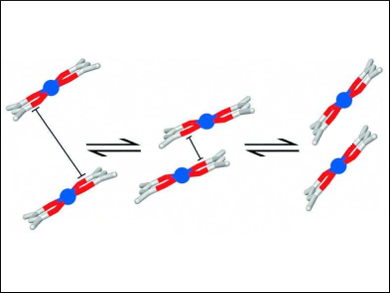Elastically flexible crystals can overcome many of the physical limitations traditionally associated with crystalline materials. They are stimuli-responsive materials and combine the molecular order of single crystals with the physical properties of soft matter. The fundamental mechanisms that lead to this behavior are not well understood yet.
Jack K. Clegg, University of Queensland, John C. McMurtrie, Queensland University of Technology, both Brisbane, Australia, and colleagues have used microfocus X-ray diffraction to map changes that [Cu(acac)2] crystals (acac = acetylacetonate) undergo upon bending. The team found that the molecules rotate to allow repeated reversible deformation (pictured right).
The researchers then used variable-temperature studies to determine the mechanism of thermal expansion. The molecular movement induced by changing the temperature is dominated by an increase in the distance between adjacent molecules (pictured left).
These results demonstrate that there are distinct differences in the mechanisms of bending and thermal expansion. This overturns the current understanding of movement in flexible crystals. However, further insights into the mechanisms of stimuli-responsive properties are required to enable the design of a range of hybrid materials.
- Elastically Flexible Crystals have Disparate Mechanisms of Molecular Movement Induced by Strain and Heat,
Aidan J. Brock, Jacob J. Whittaker, Joshua A. Powell, Michael C. Pfrunder, Arnaud Grosjean, Simon Parsons, John C. McMurtrie, Jack K. Clegg,
Angew. Chem. Int. Ed. 2018.
https://doi.org/10.1002/anie.201806431




